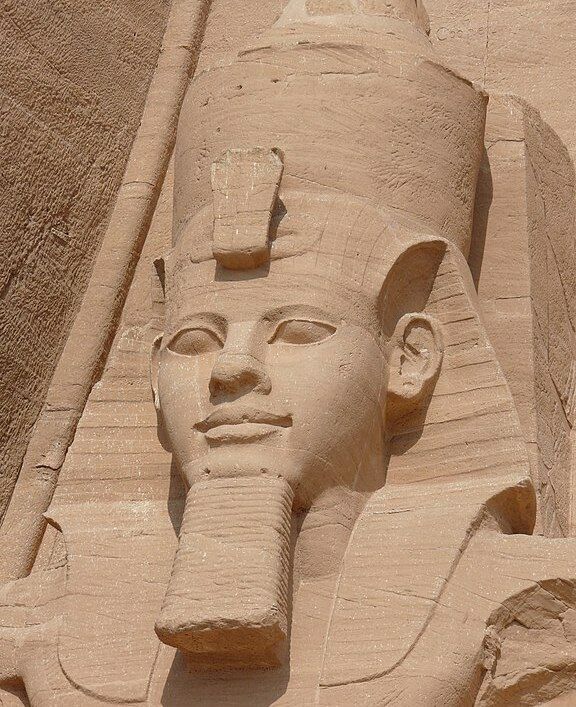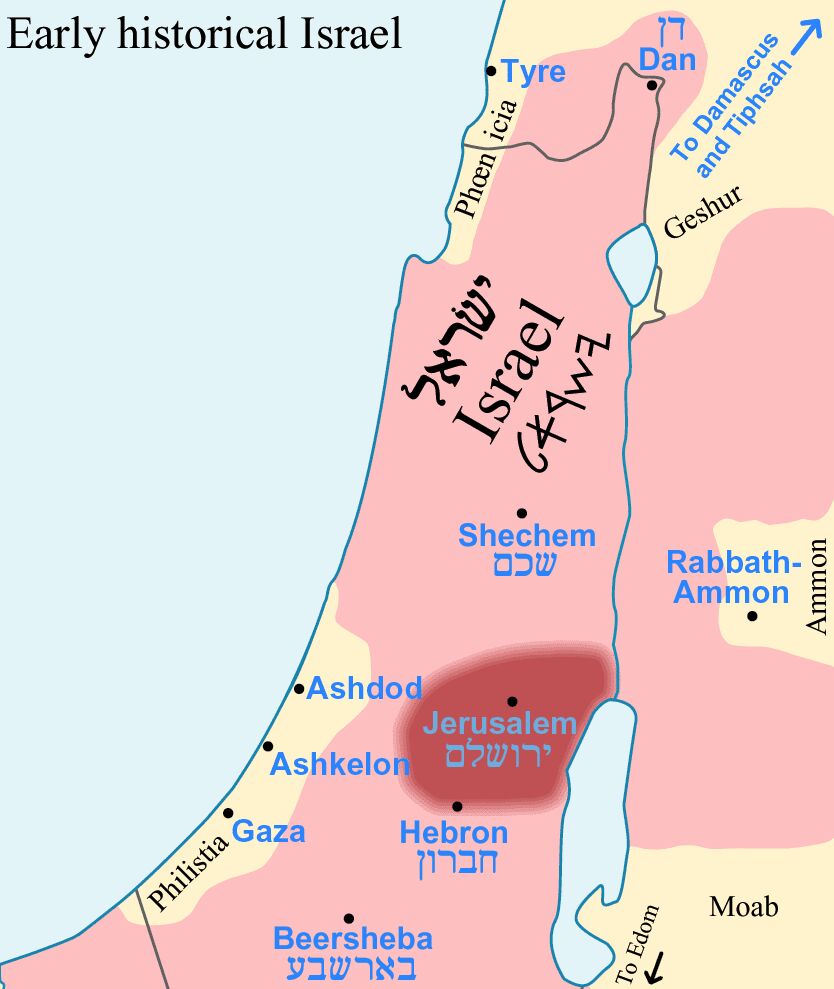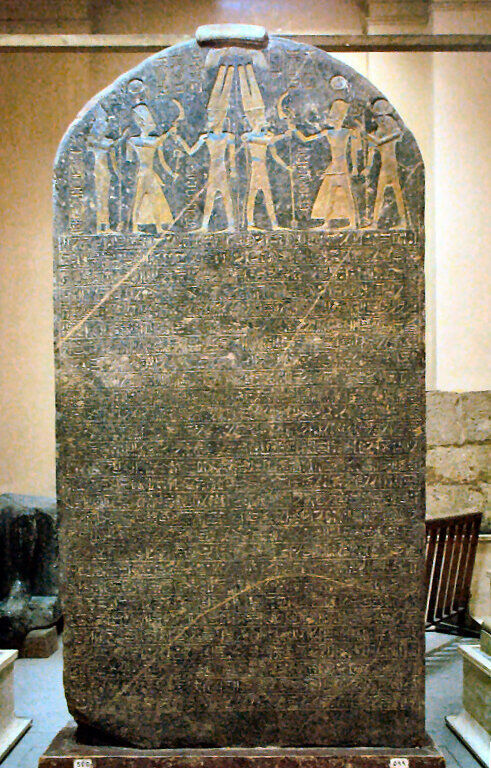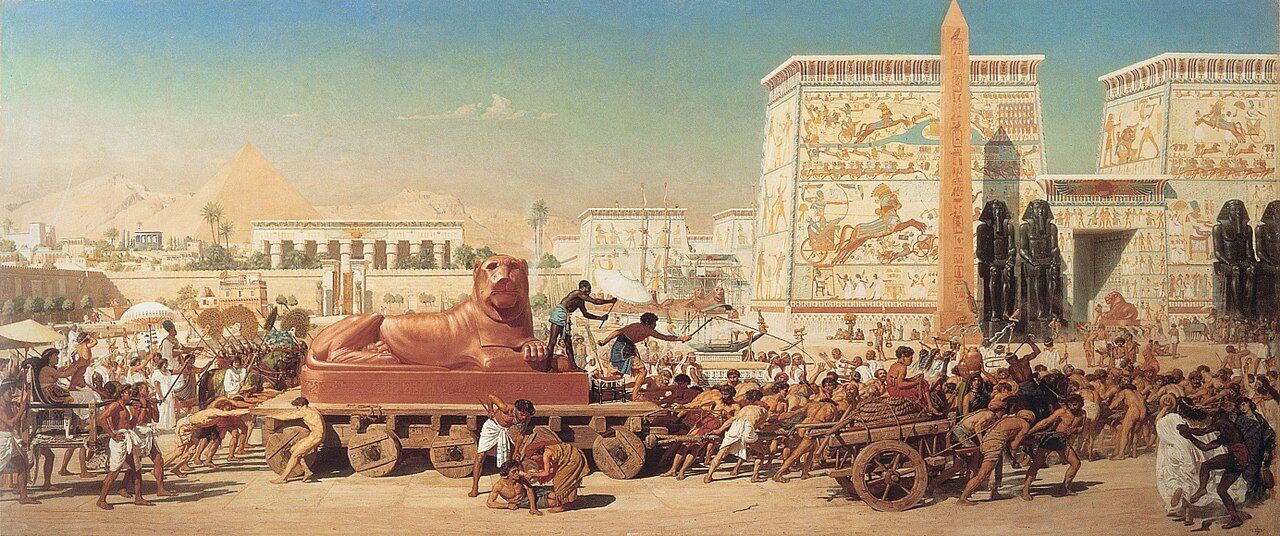“And they built for Pharaoh store-cities, Pithom and Raamses” (Exodus 1:11).
It’s one of the most vexing things for biblical archaeologists and researchers—the name of the Exodus pharaoh is not mentioned in the Bible, and neither are the prior pharaohs who enslaved the Israelites. (Yet far from being the sign of an ignorant late author, this lack of use of the pharaoh’s personal name actually reflects the specifically New Kingdom-period practice of the time.)

Nonetheless, we have a reference in Exodus 1:11 to the name Raamses (or Ramesses)—a familiar name for a series of pharaohs who came on the scene beginning in the 13th century b.c.e. (Ramesses i and ii), on into the 12th (Ramesses iii) and beyond. As such, Ramesses ii (1279–1213 b.c.e.), one of the greatest pharaohs of Egyptian history, is often identified as the pharaoh of the Exodus. His new capital, “Pi-Ramesses,” is typically identified as the one built by these Israelites.
As we covered in an earlier article, however, this 13th-century Exodus timeframe contradicts numerous other passages—such as 1 Kings 6:1, Judges 11:26, 1 Chronicles 6, and the overall internal chronology of the book of Judges, which place the Exodus some two centuries earlier—during the 15th century b.c.e. As such, this has led to a great divide in biblical scholarship, with one division adhering to the “early Exodus” somewhere around the middle of the 15th century b.c.e., and one to the “late Exodus”—a side particularly centered around this passage of Scripture, and usually identifying the Exodus pharaoh with Ramesses ii. These can arguably be defined as an early “maximalist” position and a late “minimalist” position. (Still, as severe as this sounds, both opinions actually fit within a singular overall Egyptian period known as the “New Kingdom” period, in which the Exodus account and language fits tidily.)
Our above-mentioned article makes a case for the former, the early Exodus. It argues that too many other scriptures must be dismissed or explained away in order to hold to this verse (and a couple of additional mentions of the name as a geographical marker—Exodus 12:37; Numbers 33:3-5) as a literal inference that the pharaoh at this time was Ramesses.
But what of it? For those who hold to an early Exodus position, there is a good explanation for the use of this name in Exodus 1:11. But for those who hold to a late Exodus, there is arguably also an equally justifiable answer to this explanation (as well will see). So where does this leave us? Deadlock?
Maybe not.
Early Exodus Answer: Anachronism
An anachronism is a later, typically better-known name given to something from an earlier, lesser-known time period. It is used quite frequently in history books, ancient and modern. For example, Julius Caesar conquering France: Gaul was its name then, but the anachronism “France” conveys more meaning to a modern audience.
The Bible contains several anachronisms, based on when the various books were compiled and also edited for its audience. (For example, Dan—Genesis 14:14, Judges 18; Bethel—Genesis 12:8, 28:19; Asshur/Assyria—Genesis 2:14, 10:11, 22; Amalek—Genesis 14:7, 36:12.) So as far as the use of this geographical term Raamses is concerned, based on its conflicting dating with numerous other consistent references to an early Exodus, the case can be made that this geographical name was also anachronistic. That a later edit was made to refer to an earlier, lesser-known site built by the Israelites, with a name that later readers would more readily recognize. After all, it is only mentioned as a geographic marker—never the name of the Pharaoh. (And there is just such an earlier site, fitting with the early time period: Avaris. This earlier site name is repeatedly associated with our Israelites by the earliest Egyptian source we have for the Exodus—the third century b.c.e. Manetho.)
But beyond that, we already know that the geographic term Ramesses is used anachronistically in the Bible. Undeniable precedent for this can be found in Genesis 47:11, a passage from the time of the patriarchs Jacob and Joseph, centuries earlier again, that mentions “the land of Rameses.”
There you have it, says the maximalist—“Rameses” is an anachronistic geographic term in the Bible. (And as an aside, the third-century b.c.e. Egyptian historian Manetho identifies the pharaoh as an “Amenhotep”—pharaohs with this name were on the scene from the late 16th to early 14th centuries b.c.e.) Thus, the mention in Exodus 1:11 in no way presupposes the presence of a pharaoh named Ramesses.
It’s a reasonable explanation, one we’ve made on this website. But not so fast, replies the late-date proponent.
Late Exodus Answer: Timestamp of Authorship
Egyptologist Prof. James Hoffmeier has some brilliant research corroborating the Exodus as a genuine historic event that took place during the New Kingdom Period. (His books, particularly Israel in Egypt, are highly recommended.) He states that his original position was adhering to the early Exodus timeframe, during the 15th century b.c.e. Ultimately, however, he swung to the later date (briefly explaining his reason for doing so in this video) and a preference toward Exodus 1:11 and a Ramesses ii as pharaoh of the Exodus.
Regarding the explanation of anachronism, Hoffmeier included the following brief footnote explanation in his article “What is the Biblical Date for the Exodus? A Response to Bryant Wood”:
The appearance of Rameses in the Joseph story [Genesis 47:11] reflects the period of authorship and not updating per se. Hence technically speaking it is anachronistic. If Moses were the author of Genesis and lived in Ramesside Egypt, the use of Rameses in Gen 47:11 would not be unexpected.
It’s a reasonable defense. Sure, Rameses in Genesis 47 is anachronistic. But given the recognition on both sides that Moses wrote the Torah, this place-name would only be natural for him to interpolate anachronistically in Genesis, yet use in a present-tense fashion in the book of Exodus, during the Ramesside period in which he lived.
What is the Real Timestamp of Torah Geography?
Certainly, it is the Bible-literal position that Moses wrote the Torah, the first five books of the Bible (e.g. Exodus 17:14; Numbers 33:2; Deuteronomy 31:9). That is not what is being debated here. Actually, a bulk of linguistic evidence points to just that—to the Torah having been written sometime during the New Kingdom period (see here for more detail). What is in question here is the work of later editing of the text. Hence, the general early-Exodus position that Genesis 47:11 and Exodus 1:11 are both the anachronistic product of later, post-Mosaic editing (along with, for example, the conclusion of Deuteronomy, which describes Moses’ death). Genesis 47:11 and Exodus 1:11, on the other hand, are verses which many late-Exodus proponents would simply ascribe to a Moses who lived on the scene at the time of Pharaoh Ramesses.
But note another case in point, again from Genesis. Genesis 14:14 describes Abraham and his men chasing a Mesopotamian force northward “as far as Dan” (Genesis 14:14). Judges 18 explains the manner in which this territory, formerly named Laish, was given its new name during a war initiated by members of the Israelite tribe of Dan—descendants of the biblical patriarch Dan, son of Jacob (and great-grandson of Abraham). This territorial name, therefore, is separated from Abraham by nearly half a millennium, and is as such a clear anachronism.

The reason for the anachronistic use in this passage, though, is clear in the Bible: “Dan” is one of the most frequently used border terms, used to describe the northernmost bounds of Israel (with Beersheba on the opposing, southernmost end; e.g. Judges 20:1; 1 Samuel 3:20; 2 Samuel 24:15; 1 Kings 5:5; 2 Chronicles 30:5). Thus, for the later Israelite population to understand just how far north the patriarch Abraham went, the anachronistic term “Dan” was used.
There’s another hitch, though. The naming of Dan, sometime during the first part of the period of the judges, also took place long after Moses had died. Thus, we see from this passage that an editor was at work adjusting certain such geographical reference points within the Torah sometime long after the lifetime of Moses—sometime after Laish had been conquered. (Other such examples could be cited, such as Hebron, which was still being called by its original name—Kiriatharba—during the days of Joshua; i.e. Genesis 23:2, Joshua 15:54.)
Thus, holding to an interpretation that Genesis 47:11 was simply the status quo at the time of Moses loses much of its strength when admitting that the earlier passage, Genesis 14:14 (among several others), was the work of a post-Mosaic geographic editor. And the question could therefore justifiably be asked—could such an update to Genesis 14:14 have occurred, along with the terminology in Genesis 47:11, Exodus 1:11, 12:37 and Numbers 33:3-5, all at the same time—during, or following the Ramesside period? Perhaps, for example, by the prophet Samuel (on the scene toward the end of the Ramesside period, in the 11th century b.c.e.)? Samuel, after all, is traditionally held to have written the book of Judges, with its particular emphasis on explaining to the then-present population the geographical names as they were “this day” (i.e. Judges 1:26; 6:24; 10:4; 15:19; 18:12—including this explanation of the naming of Dan).
There is another very important point here to make. Again, Moses is credited as the overall scribe of the Torah. Yet as can been clearly seen (as in the case of the border “Dan” of Genesis 14:14), there are evidently later edits that have been made to the third-person text. The Book of Deuteronomy, however, is another case entirely. This book constitutes Moses’ final, lengthy, directly-quoted first-person address to the nation. Indeed, the introduction to this book begins: “These are the words which Moses spoke unto all Israel beyond the Jordan …. And it came to pass in the fortieth year, in the eleventh month, on the first day of the month, that Moses spoke unto the children of Israel … saying:” (Deuteronomy 1:1, 3, 5). The lengthy address follows throughout the book, direct from the mouth of Moses. (It is for this reason that in Hebrew, the Book of Deuteronomy is titled Dvarim, meaning “sayings,” “words” or “utterances” of Moses.)
It is especially notable that throughout this book, this great speech of Moses, numerous place-names are mentioned, in recapping the Exodus from beginning to end. Yet there is not one mention of a place called “Rameses.” Such a place-name can only be found as a scribal note in those few verses in Genesis, Exodus and Numbers—never as a direct quote from the mouth of Moses (or as a direct quote from anyone on the scene at the time, for that matter).
Hoffmeier, for his part, presents an interesting methodology in his search for a historical Exodus: an attempt to date the Exodus using only the Book of Exodus. He writes the following in his contribution to the new publication Five Views on the Exodus: Historicity, Chronology, and Theological Implications (emphasis added):
The first half of my academic career, I was sympathetic with (but not dogmatic about) the fifteenth-century date (see Scott Stripling’s chapter). In the past twenty years, I shifted to the thirteenth-century date. The main reason for my switch was that I started framing the question differently, asking how one would date the exodus event using only the book of Exodus.
It’s an interesting angle—but one at the expense of, it could be argued, additional information from other biblical sources. Alternatively, given the above point about Moses’ address, an interesting investigative case for the period of the Exodus could be made based strictly on directly quoted material found in the Torah—i.e. much of Deuteronomy, among other direct quotes from speeches elsewhere. Scribal editing of a general third person account is one thing (i.e. Genesis 14:14; Exodus 1:11)—but a changing of directly quoted statements is quite another (i.e. Deuteronomy 4:2).
All of that being said and to one side, there is another different, arguably even stronger case against Exodus 1:11 referring to the Exodus pharaoh.
‘The King is Dead’
Again, from Exodus 1:11: “Therefore they did set over them taskmasters to afflict them with their burdens. And they built for Pharaoh store-cities, Pithom and Raamses” (Exodus 1:11).
In the above-mentioned article, Professor Hoffmeier writes: “Egyptologists have long understood the reference to Rameses to refer to Pi-Ramesses, the delta metropolis built by Ramesses ii, the 19th Dynasty monarch who reigned from 1279–1213 b.c.”
We have, therefore, the statement that the Israelites “built for Pharaoh store-cities, Pithom and Raamses.” The following verses describe the pharaoh’s attempt to kill the newborn Israelite males, to neuter the strength of their population. The next chapter then describes Moses, who miraculously escaped this gendercide, as destined to be God’s tool to save these oppressed Israelites. 40 years into Moses’ life, he fled from the wrath of the pharaoh to Midian, after killing an Egyptian who was beating a fellow Israelite. Verse 23 of chapter 2 describes that while Moses was in hiding in Midian, “it came to pass in the process of time, that the king of Egypt died” (King James Version).
Thus, if the Israelites built Pi-Ramesses for Pharaoh Ramesses ii, and then this pharaoh died while Moses was in hiding (thus opening the way for his return to Egypt), this could not have been the pharaoh of the Exodus. Perhaps he could have been one of the oppressing pharaohs prior, but not the pharaoh of the Exodus.

Actually, this is one of the related reasons that certain earlier Bible scholars held to Ramesses ii’s son and successor, Merneptah (1213–1203 b.c.e.), as the pharaoh of the Exodus. That is, until the discovery of the Merneptah stele in 1896, dating to the first part of Merneptah’s reign—a stele that has the earliest confirmed reference to the nation-state “Israel” (and which dates, according to Hoffmeier, to 1211/1210 b.c.e.). About the Merneptah Stele, Hoffmeier writes:
Over the last 50–70 years, with further reflection on the reference to Israel in the Merneptah stela and the realization that there is no biblical evidence for a segment of Israelites being in Canaan while another one is in Egypt, Egyptologists prefer Ramesses ii as the pharaoh of the exodus. John Wilson rightly concluded that the Israel stela provided a “terminus ante quem [latest possible date] for the Exodus.”
Yet according to Exodus 2:23, this oppressive pharaoh—Ramesses ii, builder of Pi-Ramesses (if that is what we are to infer from Exodus 1:11) was a pharaoh long dead before Moses even returned to Egypt, let alone the Exodus. Thus, besides contradictory chronological problems elsewhere in the Bible, this popular shift to Ramesses ii, as a pharaoh of the Exodus who oversaw the building of Pi-Ramesses and from whom Moses and the Israelites ultimately departed, stands in direct contradiction to the chronology contained within only the first two chapters of Exodus.
In order to reason around this, the position could be held that the pharaoh of Exodus 1:11 and his construction project are out of place chronologically—that the verses prior (8-10) describe a different, earlier pharaoh to verse 11—and that the verses that follow (12-22) jump back again to describing this former pharaoh. But such skipping around only highlights the weakness of the late-date, 13th century, Ramesses ii theory centered around this verse. (Another explanation rather remarkably holds that the pharaoh in Exodus 2:23 may have only figuratively died while Moses was in Midian—that, or “verse 2:23 [is] an erroneous detail that somehow made its way into our official tradition”!)
The question is therefore asked: Is even Exodus 1:11 to be discarded, at least in terms of chronological flow (either that, or Exodus 2:23)—along with Judges 11:26, 1 Kings 6:1, 1 Chronicles 6:33-38, Ezekiel 40:1, Acts 13:20, and the overall chronologies within the book of Judges (among other scriptures)—not to mention some of the earliest classical writings on the subject, by the third-century b.c.e. Manetho and first-century c.e. Josephus—in order to hold singularly firm to the notion that the geographic term in Exodus 1:11, “Raamses”—a term that we already know is used anachronistically in the Bible—should be interpreted as the name of the Exodus pharaoh?
And even all that to one side, consider the following alternative statement by A. S. Yehuda in his fantastic book The Accuracy of the Bible: The Stories of Joseph, the Exodus and Genesis Confirmed and Illustrated by Egyptian Monuments and Language:
I personally can see no strong ground why “the land of Rameses” or the City of Raamses must necessarily be associated with the name of Rameses ii, only because it happened that we do not know another previous king of the same name. There are about seventy kings who reigned 400 years before Rameses ii, between 1900 and 1600 b.c., many of whom are not known to us by name …. Who will venture to say with absolute certainty that there was not among them also a king of the name of Rameses? And after all, must the city and the land of Rameses be connected by all means with the name of a king?
Prof. Israel Finkelstein and Neil Asher Silberman “venture to say” essentially just that, in their book The Bible Unearthed, which posits a minimalist view of Bible historicity. “In the fifteenth century bce such a name is inconceivable,” they write. “The first pharaoh named Ramesses came to the throne only in 1320 bce …” (pg. 56).
Such a name is inconceivable, in the 15th century b.c.e.? Hardly—a case in point being the 16th-15th century prince Ramose, son of Pharaoh Ahmose i—an equivalent form of the same name.
After all, in his account, Manetho attests that the son of the Exodus pharaoh, Amenhotep/Amenophis, was a prince by the name of Rameses ….
Does the mention of “Raamses” in Exodus 1:11 therefore require all other consequential biblical chronological details to be discarded, driving the Exodus out of the 15th century b.c.e. and into the 13th?
Hardly; if anything, this biblical passage only helps to prove that the 13th century b.c.e. Pharaoh Ramesses ii could not have been the pharaoh of the Exodus.
Read More:
What Is the Correct Time Frame for the Exodus and Conquest of the Promised Land?
The ‘480 Years’ of 1 Kings 6:1: Just a Symbolic Number?
Jephthah’s ‘Three Hundred Years’: Evidence for the Early Exodus
The 19 Generations of 1 Chronicles 6: Evidence for the Early Exodus
The Book of Judges Fails to Mention an Egyptian Presence in Canaan—Or Does It?
Manetho’s Exodus Pharaoh, ‘Amenophis’ (Amenhotep): Any Reason to Doubt?
Who Was the Pharaoh of the Exodus?
The Amarna Letters: Proof of Israel’s Invasion of Canaan?
Jericho, Ai, Hazor: Investigating the Three Cities ‘That Did Joshua Burn’
Shiloh Sacrifices: Canaanite Or Israelite?
Amenhotep II as Exodus Pharaoh—With a Low Egyptian Chronology?

